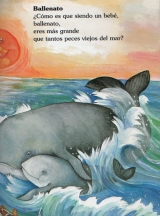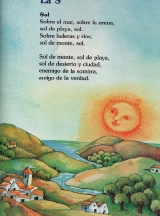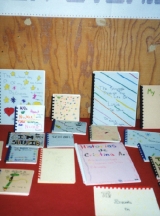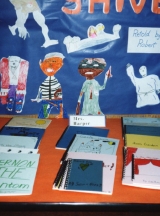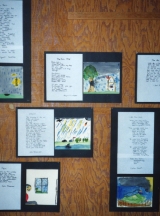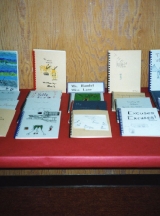Archive for November, 2009
Días de Circo
Tuesday, November 24th, 2009BOOK DESCRIPTION
A young child’s encounter with a circus artist, only slightly older than herself, opens her eyes to how different life can seem when looked at from another person’s point of view.
As all the other books in this series, Días de circo conveys the details of the world of Alma Flor’s childhood vividly, allowing the reader to witness the direct experience, and also with a poetic prose that invites sharing in the delicate feelings.
AUTHOR’S NOTE
I am frequently asked, by children and adults alike, which, among the many books I have written is my favorite. I try to explain that I cherish each of my books, because I have written each one with love and they all have taught me something about myself. But I must confess that my books of memoirs, Where the Flame Trees Bloom or Allá donde florecen los framboyanes and Under the Royal Palms or Bajo las palmas reales, as well as those in the series Cuentos con Alma, have a special significance because with them I have not only tried to capture the days of my childhood but I have honored the multiple people who made my childhood memorable. These books, as well as the memoirs I have written for adult readers, Vivir en dos idiomas have been my way of thanking those who enriched my spirit and taught me so much about trying to honor each day the gift of life.
Some of the greatest joys in my childhood came from very simple activities, as I have shared in the five books of memoirs in the series Cuentos con Alma: The making of paper boats, in Barquitos de papel, the nursery rhyme games, in Pin pin sarabín, flying kites in Barriletes, the annual visit of the humble circus, in Días de circo and the street vendor’s calls in Pregones, all held joy and life lessons.
The experience with the circus girl narrated in this book has left a permanent memory. I only hope I have been able to do justice to that moment.
READERS’ RESPONSES
If you have enjoyed reading or sharing this book, I would very much like to hear from you. Please click here to send your comments.
Tags: caribbean & latin american authors, Cuba - intellectual life, Cuba juvenile fiction, Cuba – social life and customs, Cuban American women, Cuentos con Alma, hispanic children’s literature, latino children’s literature, latino memoirs, multicultural children’s literature, people and places, Spanish, Spanish only
Posted in Childhood Memories, Children's Books, Memoirs for Children and Young Adults | No Comments »
Daniel’s Pet
Tuesday, November 24th, 2009BOOK DESCRIPTION
Daniel loves his new pet. But what will happen when it hatches a surprise? In this companion to Daniel’s Mystery Egg or El huevo misterioso de Daniel, Alma Flor Ada and G. Brian Karas team up for a heartwarming story about Daniel and his newest animal friend at an initial reading level.
Several other books by Alma Flor Ada can be discussed along side this book. Who’s Hatching Here? or ¿Quién nacerá aquí? offers the possibility to talk about animals born of eggs. A Rose with Wings or Rosa alada to talk about how interesting it is seeing a new animal come out of an egg. And The Kite or El papalote share the joy of having a pet.
G. Brian Karas has illustrated dozens of popular books, including Cinder-Elly and Sleepless Beauty by Frances Minters, Saving Sweetness and Raising Sweetness by Diane Stanley, and the HiRise Private Eyes beginning-reader series by Cynthia Rylant. He lives in Rhineback, New York. For this book he used photos of Alma Flor’s grandson Daniel to illustrate the protagonist which Daniel inspired.
AUTHOR’S NOTE
What fun it has been to be able to make my dearest grandson Daniel a protagonist of two books.
When I wrote the series Stories the Year ‘Round or Cuentos para todo el año many of the stories were inspired in my children’s childhood. As Latino children growing up in the United States some of their experiences reflected that circumstance, many others were universal, and a few were simply unique. Now, I have the blessing of being grandmother to nine children of mixed heritage, whose heritage include that of their fathers, who are both Peruvian and Cuban, and their mothers, of European ancestry with generations in the United Sates.
I enjoy making my grandchildren the protagonists of my books.
Daniel’s Pet as well as Daniel’s Mystery Egg or El huevo misterioso de Daniel honor my kind and sensitive grandson Daniel. His sister Cristina is the protagonist of Cristina and the Frog, or Cristina y la rana, and of Celebrate Halloween and Day of the Dead with Cristina and Her Blue Bunny or Celebra Halloween y el Día de Muertos con Cristina y su conejito azul.
REVIEWS
Children’s Literature
Those learning to read often turn to books that explore their interests. Keeping this in mind, Harcourt last year launched a carefully designed early-reader series called “Green Light Readers” with level one (ages 4 to 6) and level two (ages 5 to 7) books. Since many kids are intrigued by animals, Daniel’s Pet heads the list. The book offers the simple words, fun rhymes and rhythms and familiar situations that can provide important cues to those trying to master reading. Alma Flor Ada’s engaging story about a little boy acquiring and caring for his pet chick is well complemented by G. Brian Karas’ whimsical illustrations. At the end, an art project and five playful questions encourage young readers to further reflect on the book, enhancing understanding and enjoyment. 2003, Harcourt, and Ages 4 to 6. (Children’s Literature – Mary Quattlebaum )
READERS’ RESPONSES
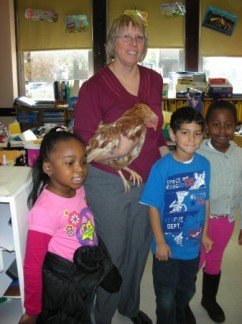 “First grade students at Franklin Elementary School in Rahway were recently visited by ‘Cooper’ the hen. Students learned all about hens and how to care for a pet when they read the story, ‘Dan’s Pet’ by Alma Flor Ada…” Read more » [New Jersey today]
“First grade students at Franklin Elementary School in Rahway were recently visited by ‘Cooper’ the hen. Students learned all about hens and how to care for a pet when they read the story, ‘Dan’s Pet’ by Alma Flor Ada…” Read more » [New Jersey today]
If you have enjoyed reading or sharing this book, I would very much like to hear from you. Please click here to send your comments.
Tags: abc books, Bilingual, bilingual children’s books, children’s literature in the elementary school, Cuban American authors, English, hispanic children’s literature, initial readers, latino children’s literature, latino poetry, multicultural children’s literature, poetry in spanish, Spanish
Posted in Children's Books, Realistic Fiction | No Comments »
Daniel’s Mystery Egg
Tuesday, November 24th, 2009BOOK DESCRIPTION
Daniel finds an egg. What kind of animal will this mystery egg hatch? Imaginations run wild as the kids in Daniel’s class guess what sort of surprise the egg has in store.
Teachers comment that this is an excellent book to practice prediction, since Daniel’s friends are actually predicting which animal may hatch from the surprising egg. Of course they are also enjoying it as a book to talk about animals who hatch from eggs.
Some teachers have paired this book with another of Alma Flor’s books: Who’s Hatching Here? – ¿Quién nacerá aquí?
G. Brian Karas has illustrated dozens of popular books, including Cinder-Elly and Sleepless Beauty by Frances Minters, Saving Sweetness and Raising Sweetness by Diane Stanley, and the HiRise Private Eyes beginning-reader series by Cynthia Rylant. He lives in Rhineback, New York. For this book he used photos of Alma Flor’s grandson Daniel to illustrate the protagonist which Daniel inspired.
AUTHOR’S NOTE
My children’s childhood has been the inspiration of many of my books. As Latino children growing up in the United States some of their experiences reflected that circumstance, many others were universal, and a few were simply unique. Now, I am the grandmother of nine children of mixed heritage, whose heritage includes that of their fathers’ who are both Peruvian and Cuban and their mothers’ of European ancestry with generations in the United Sates.
I wanted to honor my grandson Daniel, a boy of great sensitivity and kindness by making him the protagonist of this book, as of Daniel’s Pet.
REVIEWS
School Library Journal
Grade 1-2. An appealing story in which a boy finds a small white egg. He shows it to three friends, one at a time. Each child speculates as to what might be inside and how to help once it has hatched. After some waiting, what emerges is not an ostrich or an alligator or a duck, as his friends imagined, but a lizard, exactly the kind of animal Daniel predicted-“small, nice, and quiet.” Karas’s collages cover three-fourths of each spread or page and are either above or below the text. Most are in full color, with the exceptions being the illustrations that represent what the three imagine is in the egg. Those pictures are more muted and depict the kids peeking over the edges of the scenes. With large-sized type, short sentences, repeated words and phrases, and plenty of illustrations, this book is just right for beginning readers. – Kathleen Simonetta, Indian Trails Public Library District, Wheeling, IL.
Booklist
Grade 1-2. Daniel finds a little egg, puts it in a box, and shows it to his friends as they come along. The children suggest one dangerous or inconvenient animal after another that might be inside the egg, but Daniel expects a small, nice, quiet pet. To the boy’s great satisfaction, the egg hatches and a lizard emerges. Written with a simple vocabulary and growing sense of anticipation, this story will suit beginning readers well. Karas’ stylized illustrations, collages of cut paper enhanced with drawing and painting, clearly delineate between the actual and imagined scenes. A pleasing entry in the Green Light Reader series. – Carolyn Phelan
READERS’ RESPONSES
If you have enjoyed reading or sharing this book, I would very much like to hear from you. Please click here to send your comments.
Tags: abc books, Bilingual, bilingual children’s books, children’s literature in the elementary school, Cuban American authors, English, hispanic children’s literature, initial readers, latino children’s literature, latino poetry, multicultural children’s literature, poetry in spanish, Spanish
Posted in Children's Books, Realistic Fiction | No Comments »
Cuéntame un cuento: Caperucita. Los tres cerditos. Las semillas mágicas.
Tuesday, November 24th, 2009BOOK DESCRIPTION
Two traditional stories: Los tres cerditos [The Three Little Pigs] and Las semillas mágicas [Jack and the Beanstalk] have been retold in verse form by Alma Flor Ada. The verses are whimsical and provide a charming retelling of the story.
CD DESCRIPTION
The two stories contained in the book have been enriched by a third story, that of Caperucita [Little Red Riding Hood] also masterfully retold in verse by Alma Flor Ada. Suni Paz has created marvelous music turning these stories into precious songs children will enjoy listening to or singing along with. The CD is further enriched by two of Alma Flor and Suni’s signature songs, Cuéntame un cuento de hadas and Los libros son mis amigos.
AUTHOR’S NOTE
The traditional tales were an important aspect of my childhood. Later I enjoyed sharing them with my four children. Retelling well-loved stories in verse was a meaningful challenge for me, since it meant uniting two of my passions, stories and poetry.
There is always a great risk that a narrative in verse will not be true poetry. And children are much too frequently fed verses that may rhyme but are not poetry. I have always felt that this pseudo-poetry can hinder the child’s understanding of what true poetry really is, with harmful consequences. This is why these renditions were created with great care. They have been blessed by having been put to music by Suni Paz.
It is also a delight to be able to offer in this CD two of the songs Suni and I have shared with teachers all over the United States encouraging them to use them with their students as a further motivation for discovering the magic of books and story. Cuéntame un cuento de hadas and Los libros son mis amigos are easy to enjoy, sing, and remember.
READERS’ RESPONSES
If you have enjoyed reading or sharing this book, I would very much like to hear from you. Please click here to send your comments.
Tags: abc books, bilingual children’s books, children’s literature in the elementary school, Cuban American authors, hispanic children’s literature, latino children’s literature, latino poetry, multicultural children’s literature, Spanish, Spanish only
Posted in CDs, Children's Books, Fictional Narrative, Fractured Fairy Tales, Poetry | No Comments »
Coral y espuma: Abecedario del mar
Tuesday, November 24th, 2009BOOK DESCRIPTION
For each letter of the alphabet one poem about the ocean magnificently illustrated by Viví Escrivá. The poems vary in length and intention. Some are descriptive, some share feelings, others are whimsical and full of humor. Every one is musical and their rhythm inspired Suni Paz to turn them into songs.
CD DESCRIPTION
Every one of the poems has been turned into a song by renown composer and singer Suni Paz. Drawing on her intimate knowledge of folkloric musical traditions of Latin America and Spain, Suni has created original compositions for each of the 29 songs. This makes this CD a most generous gift.
AUTHOR’S NOTE
The ocean has always been very important for me: a source of enjoyment and spiritual nourishment. Surprisingly there are not many books of poetry about the ocean available for Spanish speaking children, or children learning Spanish. It has been a joy to create these for them.
Image Gallery
READERS’ RESPONSES
If you have enjoyed reading or sharing this book, I would very much like to hear from you. Please click here to send your comments.
Tags: abc books, bilingual children’s books, children’s literature in the elementary school, Cuban authors, hispanic children’s literature, latino children’s literature, latino poetry, multicultural children’s literature, poetry in spanish, Spanish, Spanish only
Posted in Audiobooks, CDs, Children's Books, Poetry | No Comments »
Barriletes
Tuesday, November 24th, 2009BOOK DESCRIPTION
The joy of flying kites brings together children and adults. A validation of family traditions and simple pastimes— and of the relationships between people and their natural environment.
AUTHOR’S NOTE
I am frequently asked, by children and adults alike, which, among the many books I have written is my favorite. I try to explain that I cherish each of my books, because I have written each one with love and they all have taught me something about myself. But I must confess that my books of memoirs, Where the Flame Trees Bloom or Allá donde florecen los framboyanes and Under the Royal Palms or Bajo las palmas reales, as well as those in the series Cuentos con Alma, have a special significance because with them I have not only tried to capture the days of my childhood but I have honored the multiple people who made my childhood memorable. These books, as well as the memoirs I have written for adult readers, Vivir en dos idiomas have been my way of thanking those who enriched my spirit and taught me so much about trying to honor each day the gift of life.
Some of the greatest joys in my childhood came from very simple activities, as I have shared in the five books of memoirs in the series Cuentos con Alma: The making of paper boats, in Barquitos de papel, the nursery rhyme games, in Pin pin sarabín, flying kites in Barriletes, the annual visit of the humble circus, in Días de circo and the street vendor’s calls in Pregones, all held joy and life lessons.
Flying kites, which in Cuba we called barriletes, was one the most beloved activities in my childhood. My father was a great kite maker and seeing him make the kites was as much a joy as flying them. I can see his careful hands smoothing the paper so that it would not have a single wrinkle, and can smell the “goma arábiga” , the golden pellets he boiled to create the glue.
My attempts, years later, to create kites for my own children inspired the book The Kite or El papalote.
READERS’ RESPONSES
If you have enjoyed reading or sharing this book, I would very much like to hear from you. Please click here to send your comments.
Tags: Cuba, Cuban American women, Cuban authors, Cuentos con Alma, family, hispanic children’s literature, latino children’s literature, latino memoirs, multicultural children’s literature, social life and customs, Spanish, Spanish only
Posted in Childhood Memories, Children's Books, Memoirs for Children and Young Adults | No Comments »
Barquitos de papel
Tuesday, November 24th, 2009BOOK DESCRIPTION
The simple experience of sailing folded paper boats after a rain storm is a window into the relationship between father and daughter
AUTHOR’S NOTE
I am frequently asked, by children and adults alike, which, among the many books I have written is my favorite. I try to explain that I cherish each of my books, because I have written each one with love and they all have taught me something about myself. But I must confess that my books of memoirs, Where the Flame Trees Bloom or Allá donde florecen los framboyanes and Under the Royal Palms or Bajo las palmas reales, as well as those in the series Cuentos con Alma, have a special significance because with them I have not only tried to capture the days of my childhood but I have honored the multiple people who made my childhood memorable. These books, as well as the memoirs I have written for adult readers, Vivir en dos idiomas have been my way of thanking those who enriched my spirit and taught me so much about trying to honor each day the gift of life.
Some of the greatest joys in my childhood came from very simple activities, as I have shared in the five books of memoirs in the series Cuentos con Alma: The making of paper boats, in Barquitos de papel, the nursery rhyme games, in Pin pin sarabín, flying kites in Barriletes, the annual visit of the humble circus, in Días de circo and the street vendor’s calls in Pregones, all held joy and life lessons.
My father, a surveyor and professor of mathematics, was also very gifted with his hands and he found ways to teach in surprising ways. There was much more to rainy days than making paper boats, although I have chosen them as the center of this vignette which speaks above all the love of a father for his young daughter.
Paper boats have remained to this day a wonderful symbol for me. I have mentioned them also in the poem La lluvia, in Do, re, mi, ¡sí, sí! book #8 in Colección Música amiga series. It has been a great joy for me that Suni Paz would create wonderful music for that poem, which she has recorded in the Do, re, mi, ¡sí, sí! CD. And the joy of paper folding is the motive for Origami in Con ton y son, book # 5 in Colección Música amiga.
READERS’ RESPONSES
If you have enjoyed reading or sharing this book, I would very much like to hear from you. Please click here to send your comments.
Tags: Cuba, Cuba - intellectual life, Cuban American women, Cuban authors, Cuentos con Alma, family, hispanic children’s literature, latino children’s literature, latino memoirs, multicultural children’s literature, social life and customs, Spanish, Spanish only
Posted in Childhood Memories, Children's Books, Memoirs for Children and Young Adults | No Comments »
Authors In The Classroom: A Transformative Education Process
Tuesday, November 24th, 2009BOOK DESCRIPTION
Alma Flor Ada and F. Isabel Campoy combine inspirational examples and practical how-to’s to create a unique resource for teachers!
Thousands of teachers have experienced the awakening of their own creative writing voice through participating in the writing courses and workshops offered by Alma Flor Ada and Isabel Campoy. The rich tapestry of these teachers’ voices is a major highlight of this book. In turn, teachers have used their own self-published works to inspire students and parents to write their own stories, and those voices are included in here as well.
In addition to offering a plethora of inspiring examples of works authored by classroom teachers, parents, and students, this book also includes practical, step-by-step activities and a solid grounding in theory. Written in a clear and reader-friendly style, this combination will enable teachers to experience the benefits of this creative approach to building strong classroom communities.
- Includes 10 thematic units, with writing starters and activities for teachers, parents, and children.
- Features sections on facilitating classroom dialogue and unlearning oppression/education for liberation.
- Showcases abundant examples of teachers’ self-published books, as well as students’ and parents’ writing.
AUTHOR’S NOTE
This book represents the fruits of eight years of joint efforts of encouraging teachers to dare to experience the joy of writing. It has also benefited from the insights of Rosalma Zubizarreta, Alma Flor’s daughter, who collaborated enthusiastically in the making of the book.
While most teachers feel comfortable sharing their enthusiasm for reading with their students, few feel equally at ease in exploring the power of authorship.
The process suggested in this book for authoring self-reflecting books, has been embraced by numerous teachers who have found that in writing personal books about themselves, their families, their life journey, and their goals as teachers bring about three distinct kinds of benefits:
- a greater self-awareness and a possibility to reevaluate their own vocation as educators
- greater confidence and strength to guide their students in their own process of discovering of voice
- a new relationship, of greater trust and equality, with the students families’ based on shared human experiences
We are extremely grateful to the teachers, families and students who have shared with us their works to be included as examples in this book and to all those others, whose words have not been reproduced in the book, but who are present in it, through all we have learned from them in the process of teaching “Authors in the Classroom” courses, workshops and seminars throughout the United States and abroad. We know many of you have been anxiously awaiting the publication of this book and it is a joy to let you know it is finally available.
COMMENDATIONS
“This book is nearly perfect. It will become a classic.” – Stephen Krashen , University of Southern California.
“Authors in the Classroom shows us what education can be and should be: a safe environment for intellect and identity to expand and connect with the collective intellectual and cultural accomplishments of our global society. As evidence for its claims about what education can achieve this text provides neither empty theory nor soulless empirical research but rather the voices of teachers, students, parents, and the authors themselves, exploring through writing the limits of human reality and potential.” – Jim Cummins, University of Toronto.
“I want to start by saying that this is a powerful book which was a joy to read. The book provides a much-needed bridge between theory and practice of Transformative pedagogy. It is what every teacher/prospective teacher looks for: a step-by-step guide to putting lofty ideological ideals into practice. The examples speak for themselves about the rich potential of the model.” – Elsa Auerbach, University of Massachusetts—Boston.
REVIEWS
Language Arts
“It is inappropriate to expect teachers to develop in their students skills with which they are not confident themselves,” claim Ada and Campoy (p.2). Authors in the Classroom shares years of these authors’ experiences working to transform teachers into authors, “from followers of other people’s agenda to shapers of our own ideas.” (p. 4). One of the most odious aspects of standardized curricula is the instruction of all students in the same way. In order to reach maximum educational potential, students; identities need nourishment. In the first chapter, Ada and Campoy educate readers in anti-bias ethics with informational text and exploration that readers can conduct on their own attitudes through journaling. This counterplay between information and reflection is the cornerstone of the book.
To live the process advocated by Ada and Campoy, teachers (readers) are encouraged to make their own writing public by “publishing” books; by doing so, they provide models that an instruct and motivate students and their families to write about and publish their own life stories and ideas. Honest, accepting dialogues, where individuals ask real questions, express different points of views, and help teach, model, practice and problem solve, provide classroom strategies that undergird the writing program.
The second half of the book contains ten units on topics such as Affirming Self, Understanding the Past, Creating the Future and Learning to Know. There are multiple examples of student-, teacher-, and family-authored writing, stimulated by rich children’s literature in many different genres. Annotated bibliographies of books for children and young adults accompany each chapter. Using this authoring process, individuals create many small books that can be read by others inside and outside their classroom. By the time you finish reading this captivating book, you have no doubt that the students who have engaged in this process will be readers and writers for life. No matter what happens during the rest of the day, this literacy format needs to fit between the cracks, for from there it will move to center stage. – Linda Leonard Lamme, School of Teaching and Learning, College of Education, University of Florida. Language Arts, Vol. 82, No. 3, January 2005, page 222
Midwest Book Review
An unusually well written and organized educational guide.
Collaboratively written by Alma Flor Ada (Director of the Center for Multicultural Literature for Children and Young Adults, University of San Francisco) and F. Isabel Campoy (a children’s books author and language acquisition expert), Authors In The Classroom: A Transformative Education Process is an unusually well written and organized educational guide aimed expressly at classroom teachers seeking to improve their own writing skills. Enthusiastically promoting creative literacy among students, teachers, and parents alike, Authors In The Classroom creatively and informatively explores means for educators to hone their own writing talents, as well as encouraging the students to live up to their fullest potential. An excellent, reflective, “user friendly” guide, Authors In The Classroom is an invaluable contribution to academic Education Studies reference collections. September 14, 2003
Amazon.com
Fabulously Rich!, March 15, 2005
Reviewer: Catherine Carrison (Vancouver, WA USA) –
Authors in the Classroom: A Transformative Education Process is an amazing resource for today’s teachers. This book, wonderfully well written and organized, guides teachers in the process of strengthening the literacy skills of their students through the strengthening of their voices. In the first part of the book the authors walk the teacher through a discussion of transformative education and the role of creative dialogue in the classroom. The second part of the book is focused on the journey of writing as it reflects areas of exploration such as Recognizing Human Qualities, Strengthening Self-Identity, Building Communities, The Power of Transformation, Understanding the Past – Creating the Future, and Learning to Know. Ada and Campoy vividly demonstrate through the use of beautiful student, teacher, and family examples how the communities of the classroom and home can be merged through the medium of written expression. Perhaps most important, they show us how powerful the telling our own stories can be – how our stories can be shared to create an affirming and fabulously enriched learning environment in our classrooms for students, their families, and teachers.
Amazon.com
An unusually well written and organized educational guide, September 14, 2003
Reviewer: Midwest Book Review (Oregon, WI USA)
Collaboratively written by Alma Flor Ada (Director of the Center for Multicultural Literature for Children and Young Adults, University of San Francisco) and F. Isabel Campoy (a children’s books author and language acquisition expert), Authors In The Classroom: A Transformative Education Process is an unusually well written and organized educational guide aimed expressly at classroom teachers seeking to improve their own writing skills. Enthusiastically promoting creative literacy among students, teachers, and parents alike, Authors In The Classroom creatively and informatively explores means for educators to hone their own writing talents, as well as encouraging the students to live up to their fullest potential. An excellent, reflective, “user friendly” guide, Authors In The Classroom is an invaluable contribution to academic Education Studies reference collections.
CITATIONS
In Sweet Company: Conversations with Extraordinary Women about Living a Spiritual Life by Margaret Wolff on page 70.
“Using Teachers’ Volunteer Experiences in the Dominican Republic to Develop Social Responsibility in Canadian Middle-School Students: An ‘Authors in the Classroom’ Approach,” by Judith K. Bernhard, Lisa Evans, Yohannys Marmolejo, Teresa Cosentino, The Inter-American Journal of Education for Democracy
http://scholarworks.iu.edu/journals/index.php/ried/
READERS’ RESPONSES
If you have enjoyed reading or sharing this book, I would very much like to hear from you. Please click here to send your comments.
Tags: authorship, creative writing, English, home school interaction, parental involvement, students authors, teachers authors, teaching writing
Posted in Books for Adults, Pedagogical, Teacher and Students as Authors | 3 Comments »
After the Storm
Tuesday, November 24th, 2009BOOK DESCRIPTION
With the help of the Sun and the cooperation of Wind, Clouds, and Rain, a little seed grows up to be a beautiful plant. This story about the cycle of growth also lends itself to discussions of cooperation and interconnectedness.
One of the beloved titles of the series Stories the Year ‘Round, or in Spanish, Cuentos para todo el año. The complete stories of the series are:
SPRING
A Rose with Wings
A Surprise for Mother Rabbit
The Empty Piñata
PRIMAVERA
Rosa alada
La sorpresa de Mamá Coneja
La piñata vacía
SUMMER
How the Rainbow Came to Be
After the Storm
In the Cow’s Backyard
VERANO
Cómo nació el arco iris
Después de la tormenta
La hamaca de la vaca
FALL
The Kite
What Are Ghosts Afraid Of?
“Turkey for Thanksgiving?” “No, Thanks!”
OTOÑO
El papalote
El susto de los fantasmas
–¿Pavo para la Cena de Gracias? –No, gracias.
WINTER
The Golden Cage
I Don’t Want to Melt
It Wasn’t Me
INVIERNO
La jaula dorada
¡No quiero derretirme!
No fui yo
CDS AND CASSETTES DESCRIPTION
Facilitating that children listen to the stories as recorded by the author has a special value. They can hear in the author’s voice just exactly how exactly the author wished to convey the stories feelings and emotions, emphasis and suspense. I particularly like to read aloud and to record my readings so, for me, it was particularly joyful to record these twelve stories in English and Spanish.
The stories can be found in individual cassettes in English and Spanish, one for each book of the series, or in CDs in English and Spanish versions. Each of the CDs contains the twelve stories of the series.
A Special Bonus
Because these stories have been so beloved by children, I conceived the idea of given them an extra dimension. I have rewritten the 12 stories in Spanish in verse format. And Suni Paz, with her incomparable creativity, has put them to music. So the Spanish cassettes and CD contain not only the story as published in the book told by me, but also the story retold in verse form and sang by Suni.
AUTHOR’S NOTE
The twelve books of this series are some of my best well known books among bilingual teachers and their students. They are also very dear to my heart since the inspiration for most of them comes from my own children’s childhood.
The major source of inspiration for this book came from my children’s interest in planting and gardening. No plot of land was too small for them to plant. When we moved to Mill Valley, California the house had a very small front garden, but they wanted to have fruit trees and we planted a tree for each of them. Later they discovered a very small strip of land between our home and the neighbors and planted potatoes. Frustrated by the fact that we did not have a backyard, only a small cemented patio they managed to find a large wooden box, which they filled with all sort of leaves and branches and some soil and were able to cultivate corn, pumpkins, onions and other vegetables.
Conversations about how plants grow were frequent and led to this story, which, as it has been pointed out to me by some of my young readers has a character that doesn’t give up easily, and persists, until it becomes a growing tree.
READERS’ RESPONSES
If you have enjoyed reading or sharing this book, I would very much like to hear from you. Please click here to send your comments.
Tags: Cuentos para todo el año, English, Spanish, Stories the Year Round
Posted in Audiobooks, Children's Books, Fictional Narrative | No Comments »
Abecedario de los animales
Tuesday, November 24th, 2009AVAILABLE IN BIG BOOK FORMAT
BOOK DESCRIPTION
This book offers two poems in Spanish for each letter of the alphabet. One poem centers on the featured animal, while the other focuses on the letter itself, playfully exploring associated sounds and shapes and meaningful words. Teachers and children have delighted in this book which has become one of Alma Flor’s classics, with numerous reprints both in hardcover and paperback. Viví Escrivá’s whimsical illustrations contribute to make this book a favorite welcoming present for a new born child, a special birthday present or simply a book that belongs in the library of every child who speaks, or is learning to speak, Spanish.
CD AND CASSETTE DESCRIPTION
The Abecedario CD or cassette is a wonderful complement to the book, facilitating children’s retention of the poems. Drawing on her broad knowledge of the Hispanic musical tradition, Suni Paz has turned each of the alphabet poems into a delightful song. The songs encompass a wide range of Latin American and Spanish rhythms, and provide an outstanding introduction to Latino children’s vast musical heritage. The tape also includes an original ABC song, a gift from Alma Flor and Suni to children and teachers.
AUTHOR’S NOTE
The ABC has always held great appeal for me. I love that it is such a wonderful tool for organizing things. I am a lover and collector of ABC books, so it is not a surprise that I have written a few.
This particular ABC was born out of my desire to do something special for a special child, Emilio, the son of Kuki Miller and Daniel Divinski, two wonderful Argentinian friends. Emilio was visiting San Francisco for the first time, and I had been looking forward meeting this child, but fell victim to the most vicious flu. It was frustrating to be in bed and not able to meet the child and take him and his mother to see the city. To try to give him something special as a memory of his trip, I began creating poems about the letters and sharing them with him on the phone. This was the inspiration for the book.
At a different level this book is also very important to me because of the professional association with three women who have been very important in my career as an author. First, someone I hold in great esteem, Felicidad Orquín. A specialist in Children’s Literature, and a remarkable author, Felicidad was at the time the Director of the Children’s Literature Section of Espasa-Calpe in Madrid, and offered me a contract to publish this book. Since then we have become friends, but this book was out first contact. The book is the product of her vision in selecting Viví as the illustrator and establishing the parameters for the book design. The collaboration with Viví on the creation of the book has been the beginning of a long career of publishing books together. Suni Paz had already created music for some of my poems, but this was the first time we produced independently first a cassette, later a CD. Suni’s musical creations for my poems have been extraordinary joys in my life.
BOOK REVIEWS
Publishers Weekly:
Young readers will enjoy learning the alphabet as they associate the letters with the names of animals. Large, colorful illustrations and simple, clever text make this a fun and educational tool.
School Library Journal:
A wonderful collection of verses about the letters of the alphabet, including imaginative descriptions of the letters and an introduction to their sounds. The text is enhanced by beautiful watercolor illustrations.
TEACHERS’ AND CHILDREN’S RESPONSES
My great love for this book derives, of course, of the extraordinary response it has had from teachers and children. It has been wonderful to visit schools and see how children knew the poems by heart, and could recite or sing them. Once in the outstanding Author’s Fair of St. Helena’s Elementary School, in St. Helena, California, the children performed the book on stage, holding big signs with the letters and moving to a wonderful choreography. I also have versions of the book made by children. Even more exciting is the fact that many children have been inspired to write their own ABC poems after reading this book. That is the greatest of all rewards!
If you have enjoyed reading or sharing this book, I would very much like to hear from you. Please click here to send your comments.
Tags: abc books, bilingual children’s books, children’s literature in the elementary school, hispanic children’s literature, latino children’s literature, latino poetry, multicultural children’s literature, poetry in spanish, Spanish, Spanish only
Posted in CDs, Children's Books, Poetry | No Comments »
